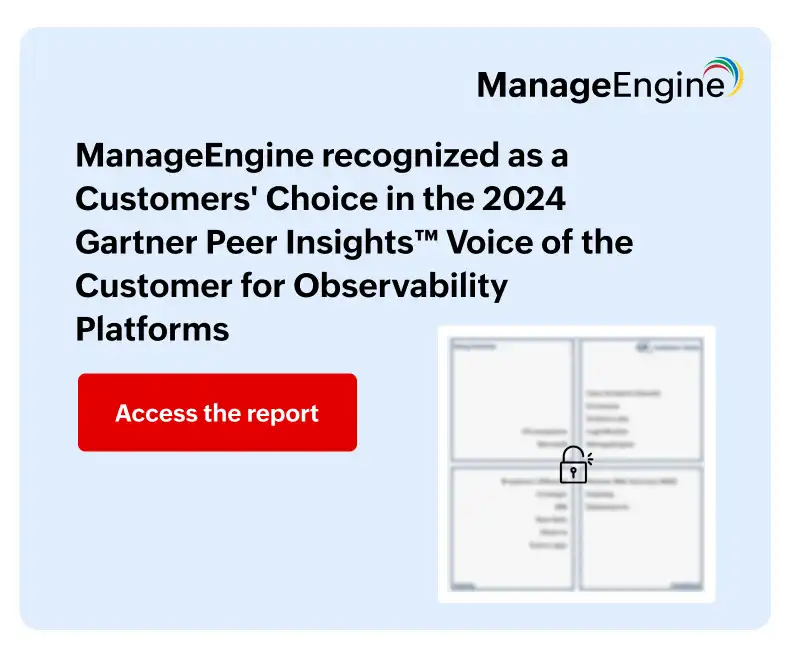Kubernetes Monitoring
Monitor Kubernetes containers across your IT infrastructure - built for enterprise scale
Effectively managing containerized applications requires comprehensive visibility and insights. Applications Manager offers Kubernetes monitoring to enhance the performance and efficiency of your Kubernetes clusters. Get empowered with actionable insights and powerful fault management for smooth and prompt resolution of issues and attain optimal container management.
Seamless integrations with your Kubernetes ecosystem
ManageEngine Applications Manager is designed to work seamlessly with the tools and platforms you already use, ensuring a smooth monitoring experience across your Kubernetes ecosystem. Here’s how we integrate with your stack:
Kubernetes-native tools
Leverage existing Prometheus metrics and scrape configurations for unified monitoring without duplication of effort and access deep cluster insights directly from the Kubernetes API.
Service mesh monitoring
Gain detailed visibility into your Istio service mesh, including traffic routing, latency, error rates, and mTLS configurations. Monitor Envoy proxies and service-to-service communication for secure and efficient microservices operations.
Applications Manager also supports other Kubernetes deployments in the cloud
Proactive Kubernetes monitoring with Applications Manager
Kubernetes monitoring is essential for optimizing performance, and navigating the complexities of Kubernetes requires the use of robust monitoring solutions to ensure optimal performance, resource allocation, and security. Applications Manager offers a comprehensive solution that can address your Kubernetes performance monitoring needs. Our advanced Kubernetes monitoring tool empowers organizations to:
- Gain multi-cluster visibility and actionable insights into the health and performance of their Kubernetes deployments, proactively identifying and resolving issues before they impact operations.
- Optimize resource utilization through intelligent tracking and altering. Get insights into resource usage patterns and optimize pod placement and resource allocation for better efficiency and cost control.
- Perform proactive RCA to help identify and address potential issues before they impact users or applications, minimizing downtime and disruptions.
- Accelerate troubleshooting and reduce the mean time to repair with intuitive dashboards, drill-down capabilities, and in-depth analytics.
- Predict and prevent issues with intelligent AI-powered analytics to ensure optimal responsiveness at all times.
Explore Kubernetes monitoring capabilities with ManageEngine Applications Manager
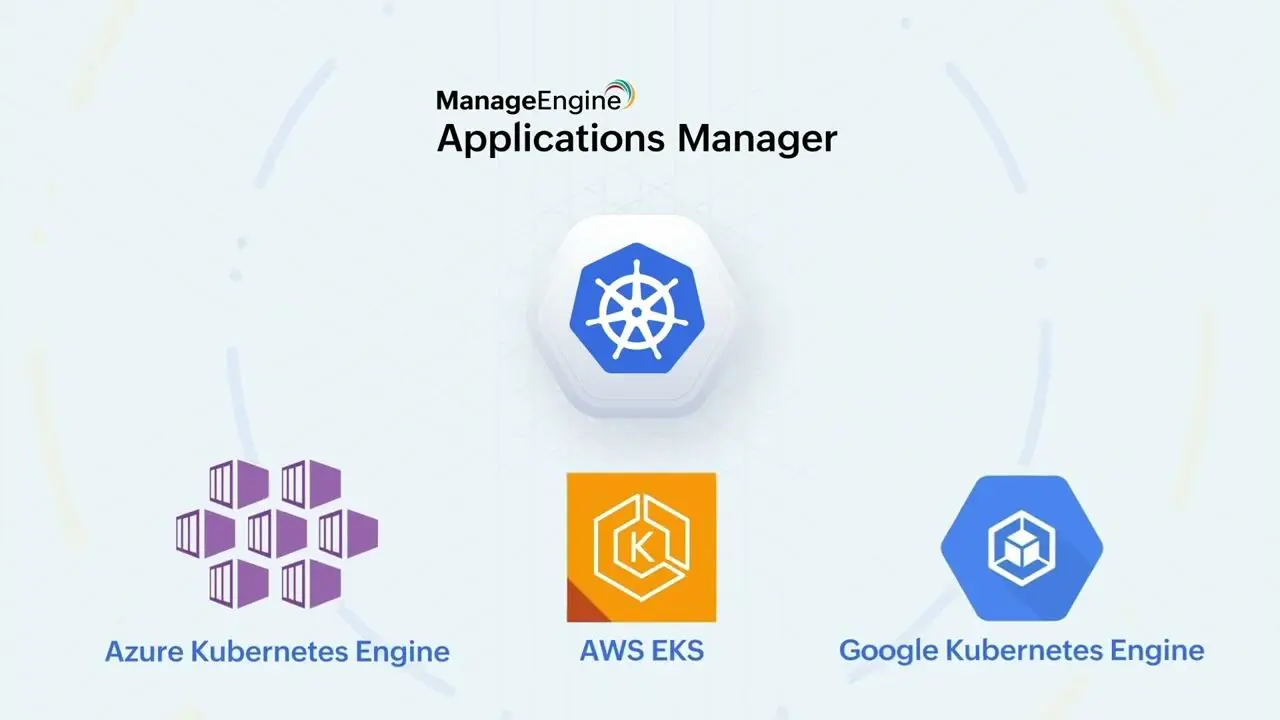
Maximize the performance and visibility of your Kubernetes environment with Applications Manager
Improve application performance, reduce infrastructure costs, and ensure a reliable containerized environment. Applications Manager empowers you to make data-driven decisions and achieve your business goals. In a complex Kubernetes environment, each component has its own unique characteristics and challenges that need to be addressed. Our Kubernetes monitoring software empowers you with a perpetual eye that discovers and monitors all the elements in your Kubernetes environment. With it, you can:
- Gain deep visibility into Kubernetes clusters.
- Minimize disruptions with proactive node health checks.
- Ensure the availability and performance of pods.
- Monitor Kubernetes-hosted applications (services and deployments).
- Keep an eye on persistent volumes.
- Real-time alerts and data-rich dashboards.
Gain deep visibility into Kubernetes clusters
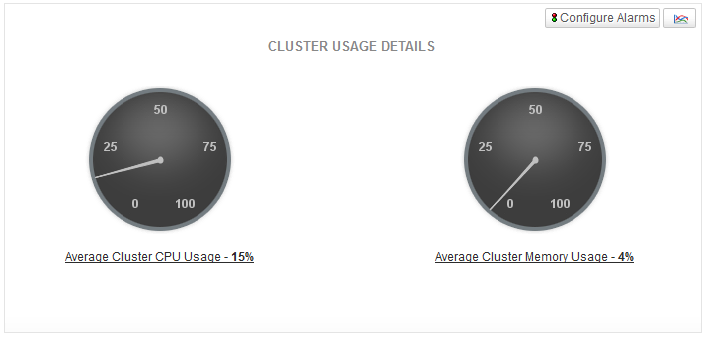
Our comprehensive Kubernetes monitoring tool offers a holistic view of your clusters, enabling you to monitor their health and performance effectively. With the ability to auto-discover Kubernetes clusters, you can map relationships between objects like nodes, namespaces, deployments, replica sets, pods, and containers. This visibility allows you to identify faults and their sources with ease, ensuring a proactive approach to cluster management.
Keep your Kubernetes deployments running smoothly by monitoring namespace details. Avoid frustrating validation errors, quickly identify downtime, and prevent accidental namespace conflicts. Exceeding memory limits leads to OOMKilled errors, causing process restarts, missed requests during boot, and slower startup times. Similarly, overconsumption of CPU results in slower transactions. In addition to monitoring, implement resource limits, and consider horizontal scaling to right-size and minimize the impact of improper resource allocation.
Applications Manager lets you monitor:
- Namespace details
- Cluster and cluster usage details
- Nodes and pods
- Component details
Minimize disruptions with proactive node health checks
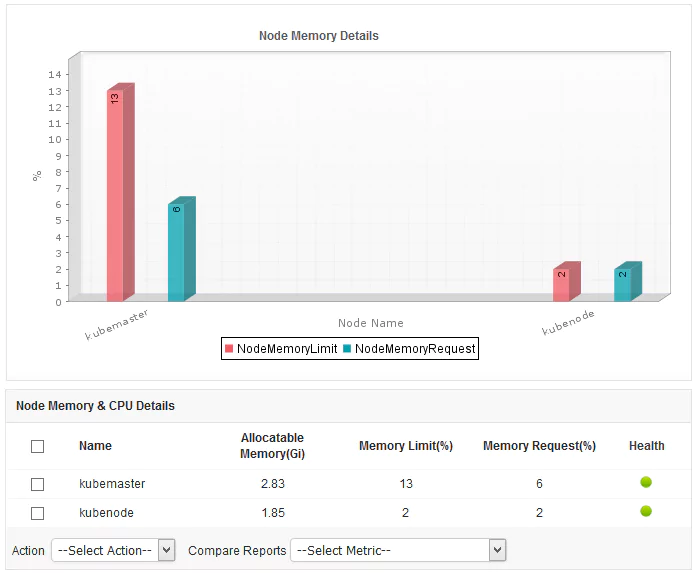
Gain deep insights into your Kubernetes environment with our comprehensive Kubernetes monitoring solution, which tracks CPU and memory utilization, network components, storage, and more. Get real-time alerts, historical data analysis, and actionable insights to:
- Scale resources dynamically: Adapt your infrastructure to changing demands, ensuring optimal performance and cost efficiency.
- Identify and resolve bottlenecks: Pinpoint resource constraints and application issues before they cause disruptions.
- Predict and prevent problems: Monitoring node pods helps you anticipate potential issues like pod unavailability, which can lead to service disruptions, and take preventive actions.
Applications Manager lets you monitor:
- Node health and availability
- Allocation of pods in nodes
- Resource utilization by nodes
Ensure availability and performance of pods
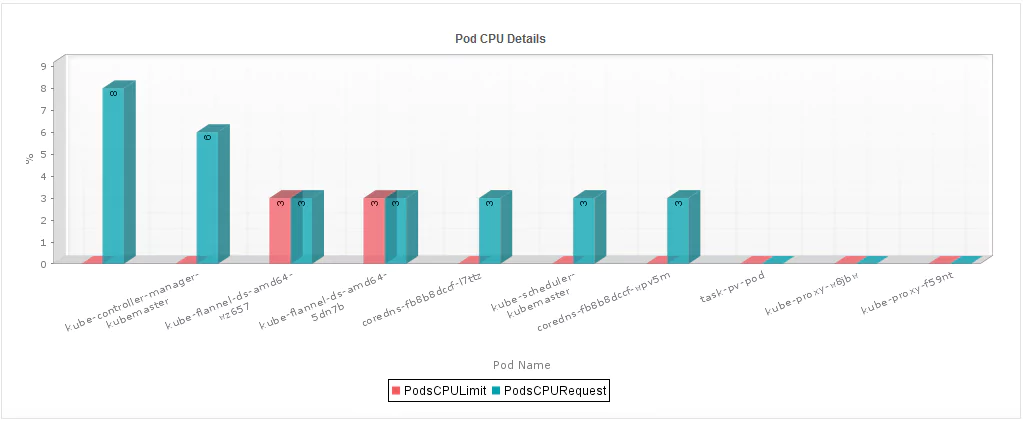
Pod availability is critical for seamless operations within Kubernetes deployments. A robust monitoring system allows you to ensure that all desired pods are running as expected and not stuck in restart loops. Failing to configure resource requests and limits can have detrimental effects on your Kubernetes cluster. Resource exhaustion due to unlimited consumption and starvation can lead to performance bottlenecks, service disruptions, and increased costs. Setting these parameters is crucial for optimal resource utilization, stability, and predictable pod behavior.
By tracking resource limitations, configuration errors, and container restarts, you can proactively address issues that may impact the performance of your applications. Set up alerts to receive notifications whenever pod-related anomalies occur, enabling swift troubleshooting.
Applications Manager lets you monitor:
- Restarts and failures for pods and containers
- The memory and CPU details of pods and containers
- Resource requests and limits
- Container stats, such as container image, status, and start time
Deep dive into Kubernetes health and performance
- Auto-discover Kubernetes clusters and track key performance metrics.
- Monitoring all the application workloads running on the cluster.
- Spot anomalies early with AI-assisted troubleshooting.
Monitor Kubernetes-hosted applications (Services & Deployments)
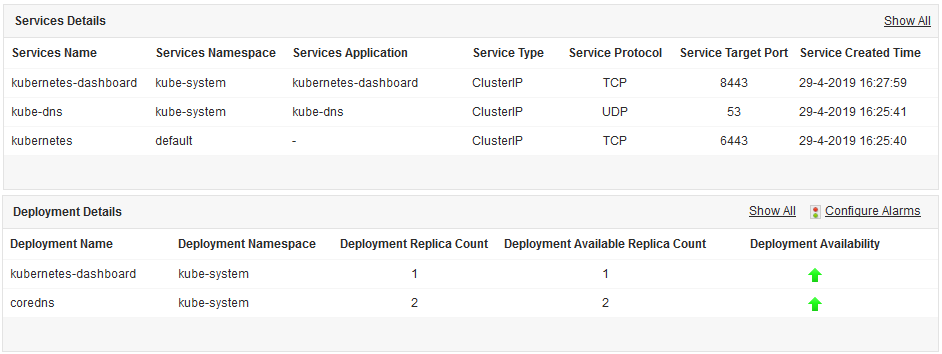
Monitoring the performance of applications running inside your Kubernetes clusters is essential for maintaining optimal performance. With advanced Kubernetes monitoring tools like Applications Manager, you can track network requests, manage services, and monitor deployments. By identifying individual errors and network request patterns, you can take proactive measures to optimize your application's performance and ensure consistent availability.
Monitoring Kubernetes services helps you ascertain the existence of a particular service, which is generally quite time-consuming without a monitoring tool. By correlating the namespaces of pods and services, and the ports with the services, you can ensure the proper functioning of pods. Mismatched pods and services or pods and ports can lead to the failure of pods.
Applications Manager lets you monitor:
- Service details
- Network protocol details for services
- Deployment stats
Keep an eye on persistent volumes
Monitoring storage classes, persistent volume claims, and persistent volumes provides valuable insights into storage utilization, reclaim policies, and data management practices. This leads to an optimized, efficient, and reliable storage infrastructure for your Kubernetes environment. Our Kubernetes monitor lets you monitor key metrics related to persistent volumes, such as PV status, capacity, and binding information, enabling administrators to identify potential issues like PV detachment or capacity exhaustion.
Applications Manager lets you monitor:
- The status, claim, access mode, storage class, and capacity of persistent volumes.
- The namespace, status, association details, access mode, storage class, and request space of persistent volume claims.
Real-time alerts and data-rich dashboards
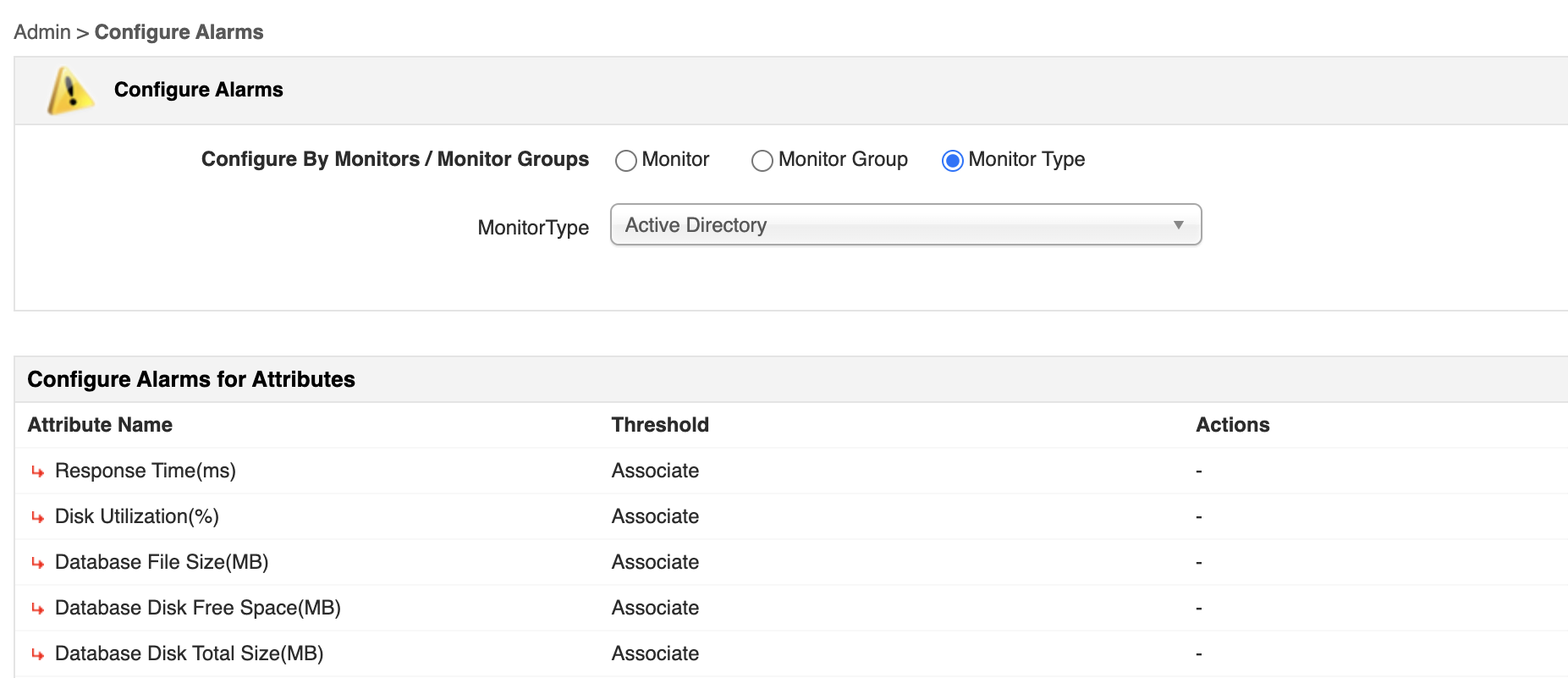
Timely alerts ensure you don't miss critical issues, and intuitive dashboards empower you to analyze data efficiently. Configure alerts based on predefined thresholds and anomaly profiles to receive notifications via various channels like Slack, SMS, or email. This allows you to take immediate corrective actions and prevent potential disruptions.
Additionally, generate comprehensive and data-rich dashboards that display key performance attributes, historical trends, and actionable insights. Leverage capacity planning reports, inventory reports, and ML-driven forecast reports to make informed decisions and optimize cluster performance.
Why choose ManageEngine Applications Manager for Kubernetes monitoring
ManageEngine Applications Manager provides comprehensive Kubernetes monitoring, offering deep insights into your clusters, nodes, and pods, all while seamlessly integrating with your existing IT infrastructure. Here's what makes us the trusted choice:
Unified monitoring across your stack
- Beyond Kubernetes: While Kubernetes is crucial, your applications likely depend on other components. ManageEngine offers unified monitoring for your entire IT stack, including VMs, physical servers, databases (SQL and NoSQL), web servers, middleware, cloud services (AWS, Azure, GCP), and custom applications. This eliminates the need for multiple monitoring tools and provides a holistic view of application dependencies.
- Application Performance Monitoring (APM) integration: Seamlessly integrate Kubernetes monitoring with robust our APM capabilities. Trace transactions across microservices and traditional components to pinpoint the root cause of performance bottlenecks, regardless of where they originate.
- Customizable dashboards: Create personalized dashboards to visualize the metrics that matter most to you. Combine Kubernetes metrics with other infrastructure and application data for a comprehensive overview of your environment.
Flexible deployment options
- On-premises: Maintain complete control over your data and comply with strict security and regulatory requirements with an on-premises installation. Ideal for organizations with sensitive data or specific compliance needs.
- Hybrid cloud support: Monitor Kubernetes deployments across on-premises, cloud, and hybrid environments from a single platform. Gain consistent visibility and control regardless of where your workloads are running.
Cost-effective without compromising on features
- Transparent pricing: Our pricing is transparent and predictable. Avoid hidden fees, complex licensing models, and unexpected costs.
- Scalable pricing: Scale your monitoring solution as your needs grow. Our flexible pricing plans ensure you only pay for what you use.
- ROI focus: We're committed to providing a cost-effective solution that delivers a strong return on investment. Our robust features and capabilities help you reduce downtime, optimize resource utilization, and improve application performance, ultimately saving you money.
Proactive monitoring & AI-powered insights
- Smart alerts: Configure intelligent alerts that notify you of potential issues before they impact users. Avoid alert fatigue with customizable thresholds and notification preferences.
- Anomaly detection: Leverage AI-powered anomaly detection to identify unusual behavior and potential problems. Our system learns the baseline performance of your applications and infrastructure, allowing it to detect deviations and alert you to potential issues.
- Root cause analysis: Rapid root cause identification is essential for fast performance problem resolution. Our fault management feature helps you pinpoint the source and fix it quickly.
- Predictive analytics: Our advanced analytics feature enables teams to anticipate resource usage and growth for upto 3 years, in addition to analyzing the historical trends.
Trusted by leading DevOps and platform engineering teams
- Ease of use: Our intuitive interface and user-friendly design make it easy to get started with Kubernetes monitoring. Reduce the learning curve and empower your team to gain valuable insights quickly.
- Proven track record: Thousands of organizations worldwide rely on ManageEngine for their Kubernetes monitoring needs. Our proven track record and commitment to customer satisfaction make us a trusted partner for DevOps and platform engineering teams.
- Community and support: Join our active community of users and benefit from our responsive support team. We're here to help you get the most out of our monitoring solution.
- Regular updates and enhancements: We're constantly updating and enhancing our monitoring platform with new features and improvements. Benefit from the latest innovations in Kubernetes monitoring.
Looking to get started with Kubernetes monitoring?
Download our 30-day, free trial, and start monitoring the performance of your K8s in just a few minutes.


